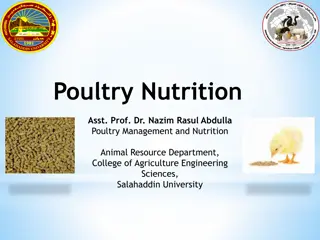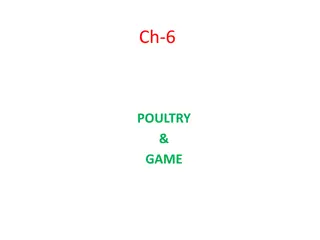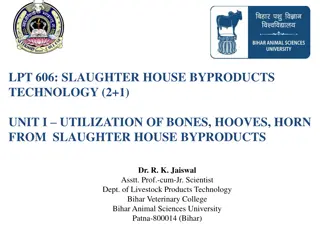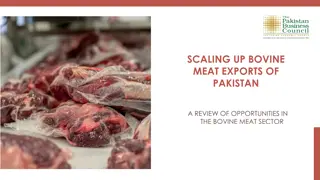Overview of Poultry Meat and Slaughterhouse Practices
Poultry meat refers to the muscle tissue, skin, and edible organs of domestic birds like chicken, ducks, geese, and turkeys, bred for food consumption. The content discusses aspects such as fat content in different poultry, types of birds like broilers and turkeys, avian anatomy, and details of the poultry slaughter process, including technical aspects and construction layout of a poultry slaughter plant.
Download Presentation

Please find below an Image/Link to download the presentation.
The content on the website is provided AS IS for your information and personal use only. It may not be sold, licensed, or shared on other websites without obtaining consent from the author.If you encounter any issues during the download, it is possible that the publisher has removed the file from their server.
You are allowed to download the files provided on this website for personal or commercial use, subject to the condition that they are used lawfully. All files are the property of their respective owners.
The content on the website is provided AS IS for your information and personal use only. It may not be sold, licensed, or shared on other websites without obtaining consent from the author.
E N D
Presentation Transcript
Poultry meat and slaughterhouse
introduction Poultry refers to live / dressed domestic birds which have been bred for edible purposes& includes; chicken, ducks, geese & turkeys. Poultry meat is the muscle tissue, skin, C.T& edible organs of avian spp,that usually used for food 30 40 days chicken weight of 2.5 kg or more. The white (breast) meat of poultry contains about 1% fat and this rises to 3% in the dark (leg) meat Poultry skin contains 33% fat, and the subdermal layers even higher amounts.
chickens duck medium fat turkey Broiler 71% Roaster 66% hen 56% Water 58% portions 20.5 20.2 16.1% Fat content 2.7 12.6 20.2 28.6%
Broiler: 7-8 weeks aged domestic fowl . Capons: 15-16 weeks old , neutered males , sold for Christmas. Turkey: 2k, 8-16 kg , traditional Christmas dish. Ducks: traditionally reared on a free range system, now reared under intensive systems .
CONSTRUCTION & LAYOUT OF AN APPROVED POULTRY SLAUGHTER PLANT
Technical aspects of slaughtering & dressing a. At the farm: 1- drug withdrowal:7 d. before slaughter 2-starving 20-8 hr 3- water withdrowal 1hr before loading 4- (4-5 birds)/ crates. Caught from legs gently. b. At the slaughter plant: 1)Unloading 2)Stunning &slaughtering 3)Plucking(defeathering) 4)Evisceration 5)Giblets 6)Cooling a. Air chilling methods b. Water chilling method.
Catching, Crating and Unloading 6-10 h plastic crates, about 10 birds per cage individually hung upside down by the feet on shackles suspended from a continuously moving line. 135 birds per minute. Ante-mortem inspection is carried out in this area.
Stunning The head of the bird sinks into a salt solution where they receive an electric shock of 120 150 V for a few seconds. Each bird have optimal voltage and current
Bleeding About 15-30 seconds after stunners jugular veins and carotid arteries at the base of the skull The birds now pass along a bleeding tunnel for at least 90 seconds for domestic fowls 50% of the blood
Scalding The birds pass through the scalder 1. 50-51 C for 3.5 min (soft scald) (fresh meat) 2. 56-58 C for 2-2.5 min (hard scald) (freezing) Salmonella & campylobacter Higher times and temperatures result in torn and discoloured skins. The scalding loosens the feathers for the defeathering process.
Plucking plucking machine Close to the scalder This consists of a rotating plate and rubber fingers that scrape the feathers of the epidermis off. Adjust to the bird size Cross contamination: scratch skin Finally, the birds are washed.
Whole bird post-mortem examination 1) Badly bled 2) emaciated birds 3) birds with septic wounds, etc. are taken off the line before they can pass through into the clean section of the slaughterhouse.
Neck slitting and foot removal A vertical incision is made in the skin on the dorsal surface of the neck to assist in the removal of the crop, oesophagus and trachea at a later stage. The feet are removed automatically
Evisceration The evisceration line runs above a water trough or a mechanical conveyor Various operations: 1. Venting. 2. Drawing. 3. Removal of offal 4. Head removal. 5. Neck removal. 6. Line washing.
Evisceration line (1) Venting: the vent is cut round so that it can be removed with the intestines from the carcass. faecal contamination of the carcass edible offal and operators hands is to be avoided.
Evisceration line (2) Drawing: All of the viscera are drawn out of the body cavity leaving them hanging from the carcass ready for inspection.
Evisceration line (3) Removal of offal: The edible offal ; heart, liver and gizzard, are removed for further cleaning and washing. The intestines, proventriculus and lungs are discarded into the water trough or mechanical conveyor.
Evisceration line (4) Head removal. This also removes the crop, oesophagus and trachea. (5) Neck removal. The necks are removed by cutting through the vertebrae between the shoulders (6) Line washing. remove blood and extraneous matter.
Cooling/chilling main objective of the chilling process is to reduce the microbial load of the raw material and to maximize the shelf life and safety of the products. 1. cold air (commonly used in Europe) refrigerated chilling rooms for 1 3 h 2. immersion chilling in cold water (long chiller with a countercurrent flow of cold water) (30-60 min) 3. combination of cold air and water misting, so-called air spray chilling
Washing & immersion chilling Washing: long spin washer tanks, water10 16 C for 10 min. The birds temperature of 36 C, exit at about 25 C. Chlorination is used at a level of 50 ppm free chlorine Chilling: Flake ice, Some chillers are fed with refrigerated water. The birds remain in the chiller tank for 30 40 minutes and leave at a temperature of 2 4 C. Draining: 10 min in chilling room
Poultry carcasses are often cut and deboned within 4 6 hours after slaughter and, thereafter, further chilled in coolers. A high relative humidity in the cooler is recommended to reduce shrinkage due to evaporation from the product surface.
Post mortem inspection (a) whole carcass inspection immediately after defeathering and before any other operation. Badly bled or emaciated birds and birds with septic wounds, etc. (b) evisceration inspection (1200 broiler fowl per hour) the viscera, body cavity (including the forward air sacs), legs and carcass must be examined. (c) final carcass inspection This takes place after the viscera have been removed and the body cavity has been washed
Post mortem inspection Unfit for human consumption: 1. Generalized infectious diseases and any localization of zoonotic microorganisms. 2. Extensive subcutaneous or muscular parasitism 3. Cachexia 4. Abnormal smell, color or taste 5. Malignant or multiple tumours 6. General spoiling or contamination 7. Major ecchymoses 8. Extensive mechanical lesion (over scalding) 9. Insufficient bleeding 10. Ascites























